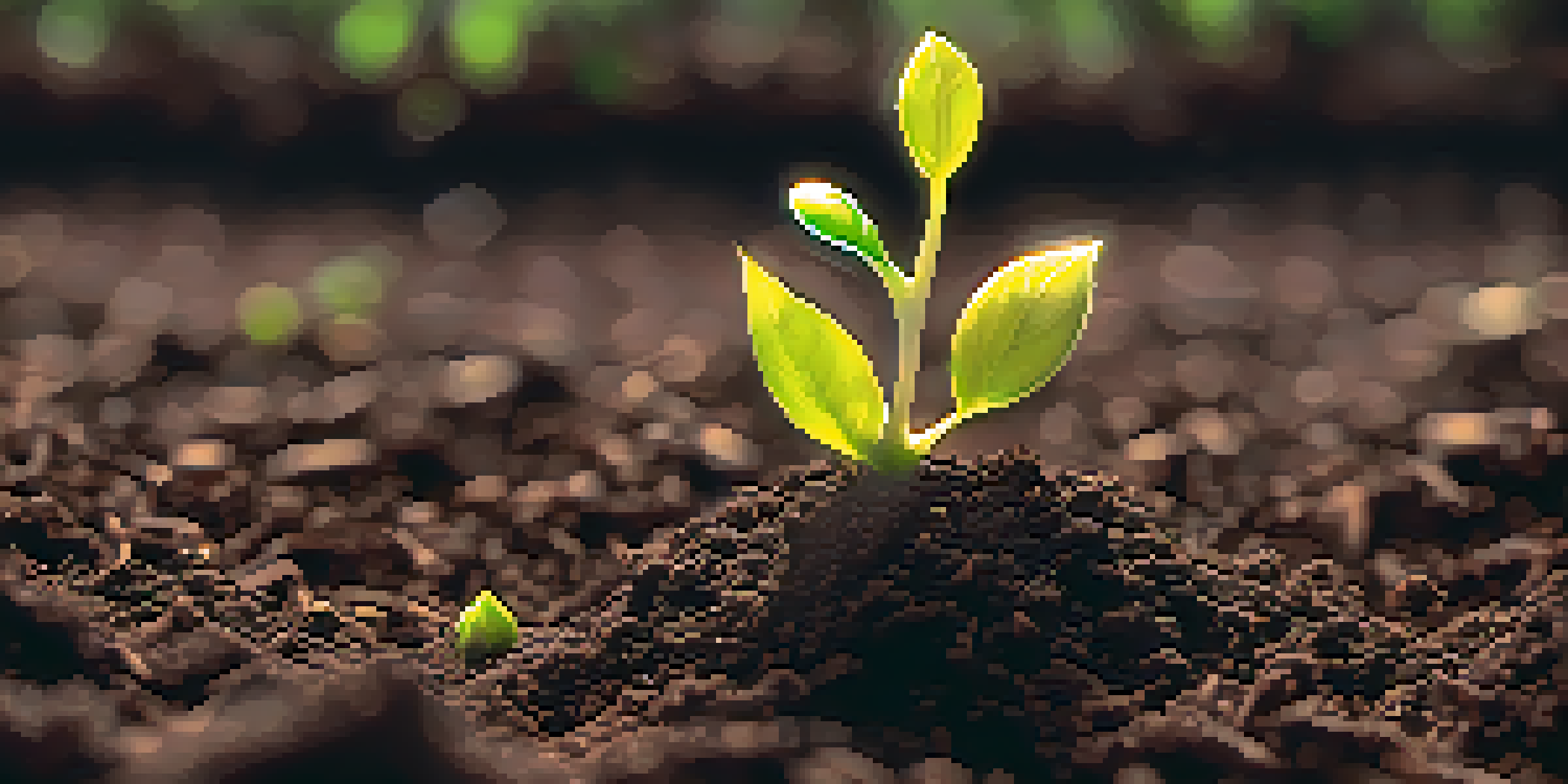The Influence of Gravity on Plant Growth and Orientation

Understanding Gravity's Role in Plant Growth
Gravity is a fundamental force that profoundly influences all living organisms, including plants. It affects how plants grow, orient themselves, and adapt to their environment. Essentially, gravity acts as a guiding force that helps plants determine which way is 'up' and which way is 'down'.
Plants are a reminder that even the smallest and simplest things have the potential for greatness.
When a seed germinates, it instinctively knows to grow its roots downward into the soil while pushing its stem upward toward the light. This behavior, known as gravitropism, is crucial for the plant’s survival, allowing it to anchor itself and access essential resources like water and nutrients.
Research has shown that gravity not only affects the direction of growth but also impacts various physiological processes. For instance, the distribution of hormones like auxins, which are responsible for growth regulation, can be influenced by gravitational pull, further shaping how plants develop.
The Mechanics of Gravitropism in Plants
Gravitropism is the process by which plants detect and respond to gravity. Roots exhibit positive gravitropism, meaning they grow toward gravitational pull, while stems show negative gravitropism, growing away from it. This dual response enables plants to maximize their ability to gather resources and thrive.

The mechanism behind gravitropism involves specialized cells called statocytes, which contain statoliths—tiny, dense structures that settle under the influence of gravity. When a plant is tilted, these statoliths shift, triggering a response that alters growth direction. It's a fascinating example of how plants have evolved to adapt to their surroundings.
Gravity Guides Plant Growth
Gravity helps plants determine their orientation, ensuring roots grow downward and stems grow upward.
Understanding gravitropism not only sheds light on plant biology but also has practical applications in agriculture and horticulture. By manipulating gravitational effects, scientists can enhance crop yields or develop plants that perform better in challenging environments.
How Light Intersects with Gravity in Plant Growth
While gravity plays a crucial role in guiding plant growth, light is another vital factor that plants respond to. This phenomenon is known as phototropism, where plants bend and grow towards light sources. The interaction between gravity and light creates a complex balance that shapes a plant's overall growth pattern.
In every walk with nature one receives far more than he seeks.
In many cases, plants prioritize light over gravity, especially in competitive environments. For example, a seedling in a dense forest may stretch toward a small gap in the canopy, even if it means growing sideways temporarily. This adaptability highlights the dynamic nature of plant growth in response to multiple environmental cues.
The interplay between gravitropism and phototropism is essential for a plant's success. By understanding how these forces work together, researchers can develop strategies to improve plant growth in various conditions, ensuring a steady supply of food and resources.
The Impact of Gravity on Plant Architecture
Gravity significantly influences a plant's architecture, which refers to its overall structure and arrangement of parts. Plants develop unique shapes and forms based on their need to optimize light capture and resource allocation while maintaining stability. For instance, tall trees have strong, deep-root systems to support their height against gravity's pull.
Moreover, plants exhibit various growth forms—such as sprawling, climbing, or erect—that are often adaptations to their gravitational environment. Climbing plants, like vines, utilize surrounding structures to elevate themselves, demonstrating how gravity can lead to innovative survival strategies.
Gravitropism and Plant Survival
The process of gravitropism allows plants to adapt their growth direction, optimizing resource access for survival.
Understanding the influence of gravity on plant architecture is crucial for landscape design, urban gardening, and agricultural practices. By harnessing these principles, we can cultivate plants that are not only beautiful but also resilient in challenging environments.
Gravity's Role in Plant Reproduction
Gravity also plays a pivotal role in the reproductive processes of plants. For many species, the way seeds are dispersed is closely linked to gravitational forces. For example, some plants have evolved mechanisms to drop their seeds directly below the parent plant, ensuring they settle in nutrient-rich soil.
Additionally, gravity can affect the growth of fruits and flowers, influencing their orientation and accessibility to pollinators. A fruit that hangs downward may be more inviting to animals, facilitating seed dispersal and enhancing reproductive success.
By studying how gravity impacts reproduction, scientists can develop new techniques for crop breeding and management. This knowledge can lead to higher yields and more efficient agricultural practices, benefiting both farmers and consumers alike.
Experimental Insights: Plants in Microgravity
The study of plant growth in microgravity conditions, such as those experienced in space, has provided invaluable insights into how gravity influences plant behavior. NASA and other space agencies have conducted experiments on the International Space Station, examining how plants adapt to an environment with minimal gravitational pull.
Interestingly, plants grown in microgravity still exhibit gravitropism, but their responses can be altered. For instance, some plants may grow more rapidly or exhibit unusual growth patterns. These findings not only expand our understanding of plant biology but also have implications for future space exploration and potential off-world agriculture.
Understanding Growth in Microgravity
Research on plant growth in microgravity conditions reveals how gravity influences plant behavior and adaptation.
By exploring how gravity—or the lack thereof—affects plant growth, researchers can develop strategies to cultivate food in space, ensuring that astronauts have access to fresh produce during long missions. It’s a remarkable intersection of science, innovation, and the resilience of life.
Conclusion: The Interconnectedness of Gravity and Growth
In conclusion, gravity plays an indispensable role in shaping plant growth and orientation. From guiding roots downward to supporting the delicate balance between light and gravity, this force is a cornerstone of plant biology. Understanding these dynamics not only enlightens our knowledge of nature but also informs agricultural practices and environmental conservation.
As we continue to explore the complexities of plant growth, it's essential to recognize the interconnectedness of various factors, including gravity, light, and nutrient availability. This holistic approach can lead to innovative solutions for food security and sustainable practices.

Ultimately, the study of gravity's influence on plant growth is more than just an academic pursuit; it’s about fostering a deeper appreciation for the natural world and the intricate processes that sustain life on our planet.